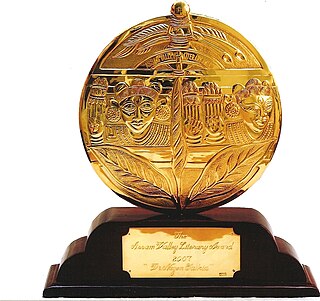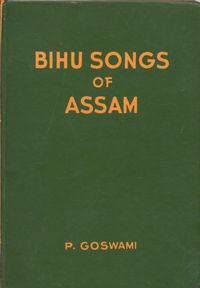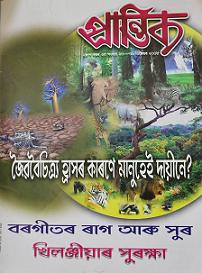 W
WAssamese literature is the entire corpus of poetry, novels, short stories, plays, documents and other writings in the Assamese language. It also includes the literary works in the older forms of the language during its evolution to the contemporary form and its cultural heritage and tradition. The literary heritage of the Assamese language can be traced back to the c. 9-10th century in the Charyapada, where the earliest elements of the language can be discerned.
 W
WThe Asam Sahitya Sabha is a non Government, non profit, literary organisation of Assam. It was founded in December 1917 in Assam, India to promote the culture of Assam and Assamese literature. A branch of the organisation named Singapore Sahitya Sabha was launched in Singapore on July 28, 2019.
 W
WThe Assam Valley Literary Award was conceived in the year 1990 by Williamson Magor Education Trust to honour creative writers who have enhanced Assamese literature.
 W
WAssamese Response To Regionalism is a book based on a study on electoral politics of Assam. The book is authored by Chandra Nath Baruah and published by Mittal Publications in 2009.
 W
WBihu Songs of Assam is a book authored by Prafulladutta Goswamil, and published by Lawyers Book Stall in 1957. The book is a collection of 262 Bihu songs collected as early as 1921, which were first put into print in 1934. Although the songs are in English, each song is later shown in original Assamese text.
 W
WHomen Borgohain is an Assamese writer and journalist. He is currently working as the editor in chief of Assamese daily Niyomiya Barta. He was awarded the 1978 Sahitya Akademi Award in Assamese language for his novel Pita Putra. Borgohain also wrote several novels, short stories and poetry. He was also the President of Assam Sahitya Sabha.
 W
WGunamala is a scripture written by Sankardev within one night at the request of Koch king Nara Narayan in 1552. It is an abridged version (handbook) of Bhagavata Purana capturing in racy, rhyming and sonorous verses. The poet recounts many incidents from Lord Krishna's life making them easy to remember in this book.
 W
WJyotiprasad as a Film Maker is a book about famed director Jyoti Prasad Agarwala authored by Apurba Sarma and published by Rajib Baruah of Adi Publication on behalf of the Gauhati Cine Club. The book was released on 17 June 2005 on the occasion of Xilpi Divas, the filmmaker's birthday. The book covers the concepts and ideas of Jyotiprasad's filmmaking and depicts the national and international cinematic scene of his time.
 W
WKamakhya, A Socio-Cultural Study is a comprehensive book on the Kamakhya temple complex in Guwahati, Assam. The book is authored by Nihar Ranjan Mishra and published by D. K. Printworld Pvt Ltd in 2004. The book makes a detailed study of the temple rituals, festivals and personnel and socio-cultural life and includes an account on spread of Saktism in the region.
 W
WThe Man from Chinnamasta is a novel published in 2005 and written by Indira Goswami, who was awarded the Sahitya Akademi Award in 1983, the Jnanpith Award in 2001 and the Prince Claus Awards in 2008. Set in pre-independence British Assam, it was written with a specific political vision : to exhort her readers to protest against the practice of animal sacrifice in the ancient Kamakhya Temple in Assam. Once published, it took Assam by storm because of its subversive nature. The Brahmins especially took offence for her frank demand to remove an ancient practice in the most important Shakti temple of the world.
 W
WMelodies and Guns is a poetry collection in English, edited by Indira Goswami and authored by Megan Kachari, the arrested Central Publicity Secretary of ULFA. The original version is in Assamese with the title Memsahib Prithibi published in 1990. It was translated into English by Pradeep Acharya and Manjeet Baruah and published by UBS Publishers Distributors Ltd, Delhi in 2006. The preface of the book is written by Jnanpith Awardee Indira Goswami.
 W
WNellie, 1983 is an Assamese book written by Diganta Sharma based on the Nellie massacre that took place during the Assam Movement in 1983. The book is published by Eklabya Prakashan, Jorhat, Assam.
 W
WOrunodoi or Arunodoi is the first Assamese-language magazine published from Sibsagar, Assam, in 1846. This magazine created a new era in the world of Assamese literature and gave birth to notable authors such as Anandaram Dhekial Phukan, Hemchandra Barua, Gunabhiram Barua, and Nidhi Levi Farwell. The magazine took the initiative of innovating the then Assamese dialect instead of borrowing words from other languages. The Assamese people got to know about the western world only through this magazine, which opened the gate to the modern literacy in Assam. It mainly included various news related to current affairs, Science, astrology, history and also trivia although Christianity was its main aim. The magazine's publishing ended when the printing press was sold in 1883.
 W
WPerspectives on Cinema of Assam is a book on the history of cinema of Assam, edited by Manoj Borpujari and Dr Garima Kalita. The book was published by Gauhati Cine Club in 2008. The book has a number of articles written by well-known authors who have traced the evolution of cinema in Assam from its birth to the contemporary stage including Documentary and the growth of the film industry. There is also an exclusive article on the Film Society Movement in Assam with a documentation of the entire list of films made in Assam from 1935 to 2007.
 W
WPrantik is a multi-topic Assamese language magazine published fortnightly from Guwahati since 1981. It plays a vital role in the socio-political lives of the people of Assam, India. The founder chief editor of the magazine was Bhabendranath Saikia. The founder editor was Pradip Baruah, who is also its present editor after more than three decades.
 W
WSecret killings of Assam: The Horror Tales from the Land of Red River and Blue Hills is a compilation of reports on secret-killings of family members of ULFA by active connivance of Indian security forces between 1998 and 2001. It is based on reports of an enquiry commission formed for it as well as numerous news reports published at that time. It is written by three veteran journalists - Mrinal Talukdar, Utpal Borpujari and Kaushik Deka who also used to write on that issue when it was on peak time. The book with 202 pages was published by Nanda Talukdar Foundation in January 2009.
 W
WThe Seven Sisters of India: Tribal Worlds Between Tibet and Burma is a book by Aglaja Stirn and Peter Van Ham and published by Prestel Publishing in 2001. The book is the first comprehensive publication on India's remote northeast starting from Tibet in the north to Myanmar (Burma) in the south and in between the North eastern states of India. This is an area where people continue a way of life steeped in ancient ritual which is scarcely known to the western world and hence rarely visited by foreigners. The book explains and illustrates the various aspects of these cultures with numerous high-quality color photographs.
 W
WO Mur Apunar Dekh Assamese pronunciation: [o mʊɹ apʊnaɹ dɛx] in Assamese) is the state song of Assam, India. It was written by Lakshminath Bezbarua and attuned by Kamala Prasad Agarwala. The song itself is from among the finest poems created by Laxminath Bezbaroa. It was first published in 1909 in an Assamese magazine named Bahi ("flute"). It was officially adopted as the Assam's state song in 1927 at asom chatrô sônmilôn held in Tezpur.